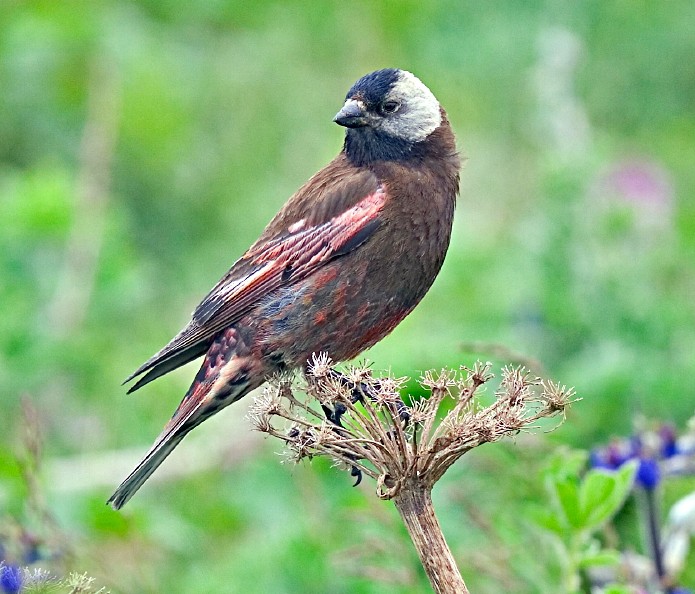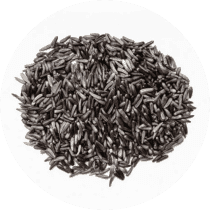Gray-crowned Rosy-finch
A species of Rosy-finches and Asian Mountain-finches, Also known as Grey-crowned Linnet Scientific name : Leucosticte tephrocotis Genus : Rosy-finches and Asian Mountain-finches
Gray-crowned Rosy-finch, A species of Rosy-finches and Asian Mountain-finches
Also known as:
Grey-crowned Linnet
Botanical name: Leucosticte tephrocotis
Genus: Rosy-finches and Asian Mountain-finches
Content
Description General Info
 Photo By Alan D. Wilson , used under CC-BY-SA-3.0 /Cropped and compressed from original
Photo By Alan D. Wilson , used under CC-BY-SA-3.0 /Cropped and compressed from original Description
Within the finch family, the gray-crowned rosy finch is medium-large with a comparatively long notched tail and wing. Adults are brown on the back and breast and mainly pink on the rest of the underparts and the wings. The forehead and throat are black; the back of the head is grey. They have short black legs and a long forked tail. There is some variability in the amount of grey on the head. Adult females and juveniles are similar. Overall length is 140 to 160 mm (5.5–6.3 in), wingspan 33 cm (13 in), and weight 22 to 60 g (0.78–2.12 oz). L. t. wallowa has an almost entirely gray head. The Pribilof and Aleutian subspecies have a length of 170 to 210 mm (6.7–8.3 in) and weight of 42 to 60 g (1.5–2.1 oz), about twice the size of the other subspecies. The black rosy finch has a black instead of brown body and the brown-capped rosy finch is a lighter brown and lacks the gray face patch. 
Size
15-15 cm (5.75-6 in)
Colors
Brown
Black
Red
Gray
White
Pink
Life Expectancy
6.6 years
Nest Placement
Cliff
Clutch Size
2 - 6 eggs
Feeding Habits
Gray-crowned Rosy-finch's diet primarily consists of seeds and insects. They forage on open terrain, hopping on varying surfaces from snow to talus, and occasionally catch insects midair. Their plant diet includes seeds from a wide range of species, while their insect diet features various beetles, flies, and moths, with a greater emphasis on insect consumption during warmer months.
Habitat
Gray-crowned Rosy-finch predominantly dwell in alpine zones beyond the treeline and tundra terrains. They thrive at high altitudes, with habitats including areas near glaciers, talus slopes, and cliffs. Geographically, their range extends from the northern Rocky Mountains to the Yukon and Alaska. In winter, gray-crowned Rosy-finch may move to lower elevations, including snow-covered hillsides, meadows, and occasionally near human settlements.
Nest Behavior
Gray-crowned Rosy-finch sees the female selecting the site and constructing the nest with minimal male help.
Nest Characteristics
Gray-crowned Rosy-finch's nests are typically found in cracks or holes on rocky cliffs, concealed areas, or occasionally on the ground or buildings. Nests are bulky cups, around 4.6 inches across and 3 inches tall, made from mosses, lichens, grasses, and sedges, and lined with softer materials like grasses, hair, wool, and feathers.
Dite type
Granivorous
General Info
Feeding Habits
Bird food type

Black Oil Sunflower Seeds

Hulled Sunflower Seeds

Nyjer
Bird Feeder Type

Large Tube Feeder

Small Tube Feeder

Large Hopper

Small Hopper
Behavior
Gray-crowned Rosy-finch demonstrate monogamous mating behaviors, engaging in elaborate courtship displays such as wobbling hops, feather fanning, and singing. Post-mating, pairs exhibit strong pair-bonding, with males closely guarding their mates and providing defense against rivals. Both sexes participate in incubation and chick-rearing, showcasing a collaborative parental approach. Their social structure extends post-fledging, as families forage together and merge into larger flocks, especially during non-breeding seasons. Notably, flock dynamics include squabbles over food and heightened aggression as breeding season nears, indicating a complex spectrum of social interactions within their habitat.
Distribution Area
The ancestor of the three species of North American rosy finches migrated from Asia. All rosy finches live in an alpine or tundra environment. The gray-crowned rosy finch has a wide range and large numbers throughout Alaska, and western Canada and the United States. L. t. griseonucha permanently resides in the Aleutian Islands and umbrina on the Pribilof Islands. A small number of gray-crowned rosy finches winters on the mainland in South-Central Alaska and visits feeders there. The other taxa: littoralis, tephrocotis, wallowa, and dawsoni are found from the Canadian and American Rockies and migrate south to the western United States. L. t. tephrocotis summers from Montana to the Yukon, while littoralis breeds closer to the coast, from northern California to west-central Alaska. Due to its remote habitat, few of its nests have been found, it is rarely spotted, and the population is stable. They are invariably found amongst rocks. The areas the subspecies breed in rarely overlap during breeding season. Males typically outnumber females throughout the year. An individual was seen north of Boonville, in Lewis County, NY beginning on Sunday, March 4 through at least Thursday, March 8. This is only the second confirmed report for New York State. 
Species Status
Not globally threatened.